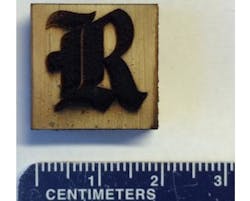Rice University chemists make conductive laser-induced graphene from wood
Scientists at Rice University (Houston, TX) have made wood into an electrical conductor by turning its surface into graphene.1
Rice chemist James Tour and his colleagues used carbon dioxide (CO2) laser scribing to blacken a thin-film laser-induced graphene (LIG) pattern onto a block of pine. Laser-induced graphene was discovered at Rice in 2014.
Previous iterations of LIG were made by heating the surface of a sheet of polyimide, an inexpensive plastic, with a laser. Rather than a flat sheet of hexagonal carbon atoms, LIG is a foam of graphene sheets with one edge attached to the underlying surface and chemically active edges exposed to the air.
Not just any polyimide would produce LIG, and some woods are preferred over others, Tour says. The research team led by Rice graduate students Ruquan Ye and Yieu Chyan tried birch and oak, but found that pine's cross-linked lignocellulose structure made it better for the production of high-quality graphene than woods with a lower lignin content. LIG has a high conductivity on the order of 10 Ω per square.
As with polyimide, the process takes place with a standard industrial CO2 laser at room temperature and pressure and in an inert argon or hydrogen atmosphere. Without oxygen, heat from the laser doesn't burn the pine but transforms the surface into wrinkled flakes of graphene foam bound to the wood surface. Changing the laser power also changed the chemical composition and thermal stability of the resulting LIG. At 70% power, the laser produced the highest quality of what they dubbed P-LIG, where the P stands for pine.
The lab took its discovery a step further by turning P-LIG into electrodes for splitting water into hydrogen and oxygen and supercapacitors for energy storage. For the former, they deposited layers of cobalt and phosphorus or nickel and iron onto P-LIG to make a pair of electrocatalysts with high surface areas that proved to be durable and effective.
Depositing polyaniline onto P-LIG turned it into an energy-storing supercapacitor that had usable performance metrics, Tour says.
"There are more applications to explore," Ye says. "For example, we could use P-LIG in the integration of solar energy for photosynthesis. We believe this discovery will inspire scientists to think about how we could engineer the natural resources that surround us into better-functioning materials."
Tour sees an environmental benefit from biodegradable electronics, noting that "graphene is a thin sheet of a naturally occurring mineral, graphite, so we would be sending it back to the ground from which it came along with the wood platform instead of to a landfill full of electronics parts."
Source: http://news.rice.edu/2017/07/31/need-graphene-grab-a-saw-2/
REFERENCE:
1. Ruquan Ye et al., Advanced Materials (2017); doi: 10.1002/adma.20170221
About the Author
John Wallace
Senior Technical Editor (1998-2022)
John Wallace was with Laser Focus World for nearly 25 years, retiring in late June 2022. He obtained a bachelor's degree in mechanical engineering and physics at Rutgers University and a master's in optical engineering at the University of Rochester. Before becoming an editor, John worked as an engineer at RCA, Exxon, Eastman Kodak, and GCA Corporation.

